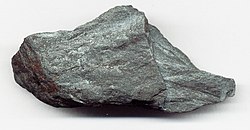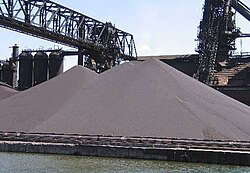Bijih besi: Perbezaan antara semakan
Tiada ringkasan suntingan |
Tiada ringkasan suntingan |
||
| Baris 1: | Baris 1: | ||
bijih besi ialah sejenis mineral yang dijumpai di kerak bumi. |
bijih besi ialah sejenis mineral yang dijumpai di kerak bumi. |
||
[[Image:HematitaEZ.jpg|thumb|250px|Hematite: the main iron ore in Brazilian mines]] [[Image:LightningVolt Iron Ore Pellets.jpg|thumb|250px|This stockpile of iron ore pellets will be used in [[steel]] production.]] '''Iron ores''' are [[Rock (geology)|rocks]] and [[mineral]]s from which [[metal]]lic [[iron]] can be economically extracted. The [[ore|ores]] are usually rich in [[iron oxide]]s and vary in color from dark grey, bright yellow, deep purple, to rusty red. The iron itself is usually found in the form of [[magnetite]] ({{Chem|Fe|3|O|4}}), [[hematite]] ({{Chem|Fe|2|O|3}}), [[goethite]] ({{Chem|Fe|O|(OH)}}), [[limonite]] ({{Chem|Fe|O|(OH)|.n(H<sub>2</sub>O)}}) or [[siderite]] ({{Chem|Fe|C|O<sub>3</sub>}}). Hematite juga dikenali sebagai "bijih semulajadi", a name which refers to the early years of mining, when certain hematite ores containing up to 66% iron could be fed directly into iron-making blast furnaces. Iron ore is the raw material used to make [[pig iron]], which is one of the main raw materials to make [[steel]]. 98% of the mined iron ore is used to make steel.<ref>{{cite web |url=http://www.mii.org/Minerals/photoiron.html |title= IRON ORE -Hematite, Magnetite & Taconite |work=Mineral Information Institute |accessdate=7 April 2006}}</ref> Indeed, it has been argued that iron ore is "more integral to the global economy than any other commodity, except perhaps oil".<ref name="Iron ore pricing"/> |
|||
== Nota == |
|||
{{reflist|2}} |
|||
==Rujukan == |
==Rujukan == |
||
Semakan pada 12:28, 20 Ogos 2011
bijih besi ialah sejenis mineral yang dijumpai di kerak bumi.


Iron ores are rocks and minerals from which metallic iron can be economically extracted. The ores are usually rich in iron oxides and vary in color from dark grey, bright yellow, deep purple, to rusty red. The iron itself is usually found in the form of magnetite (Fe3O4), hematite (Fe2O3), goethite (FeO(OH)), limonite (FeO(OH).n(H2O)) or siderite (FeCO3). Hematite juga dikenali sebagai "bijih semulajadi", a name which refers to the early years of mining, when certain hematite ores containing up to 66% iron could be fed directly into iron-making blast furnaces. Iron ore is the raw material used to make pig iron, which is one of the main raw materials to make steel. 98% of the mined iron ore is used to make steel.[1] Indeed, it has been argued that iron ore is "more integral to the global economy than any other commodity, except perhaps oil".[2]
Nota
- ^ "IRON ORE -Hematite, Magnetite & Taconite". Mineral Information Institute. Dicapai pada 7 April 2006.
- ^ Ralat petik: Tag
<ref>tidak sah; teks bagi rujukanIron ore pricingtidak disediakan
Rujukan
- Gordon, Robert B. (1996), American Iron 1607-1900, The Johns Hopkins University Press
- Rostoker, William; Bronson, Bennet (1990), Pre-Industrial Iron: Its Technology and Ethnology, Archeomaterials Monograph No. 1
- Turner, Thomas (1900), The Metallurgy of Iron (ed. 2nd), Charles Griffin & Company, Limited
- Kato, Makoto and Susumu Minowa (1969), "Viscosity Measurement of Molten Slag- Properties of Slag at Elevated Temperature (Part 1)", Transactions of the Iron and Steel Institute of Japan, Tokyo: Nihon Tekko Kyokai, 9, m/s. 31–38
- Rosenqvist, Terkel (1983), Principles of Extractive Metallurgy, McGraw-Hill Book Company
- Rostoker, William; Bronson, Bennet; Dvorak, James (1984), "The Cast-Iron Bells of China", Technology and Culture, The Society for the History of Technology, 25 (4), m/s. 750–767, doi:10.2307/3104621, JSTOR 3104621
